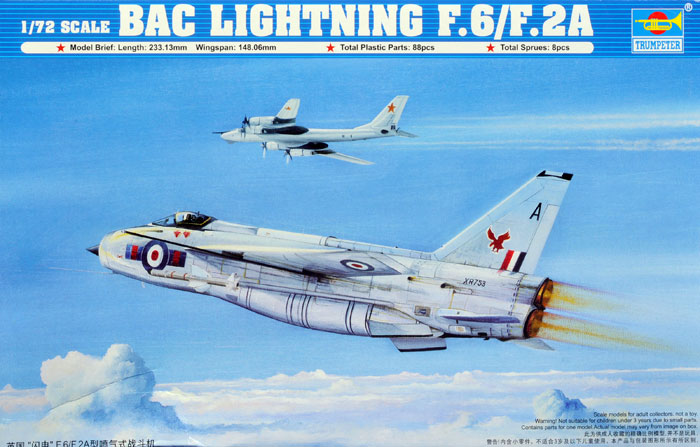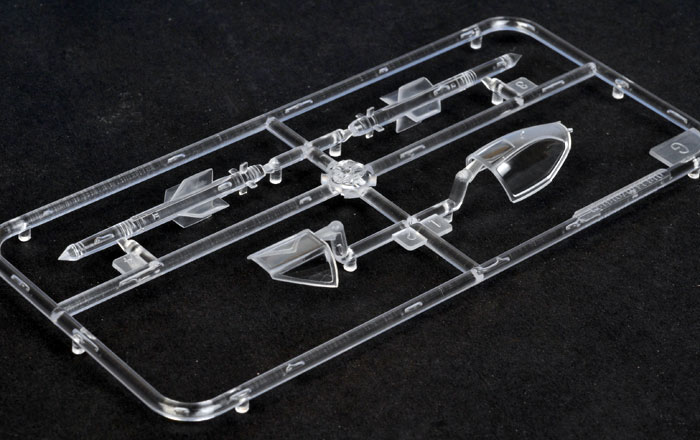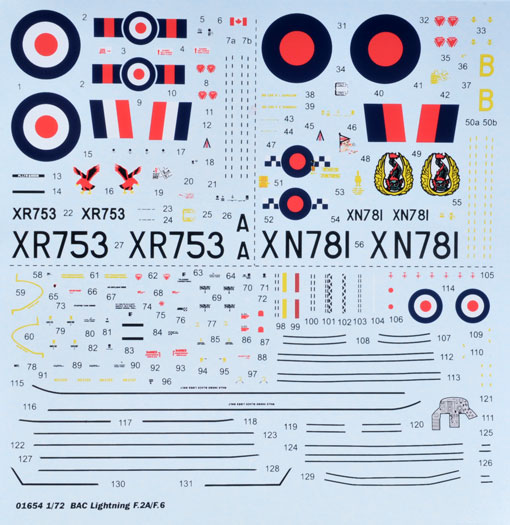Lightning F.2A / F.6

Trumpeter, 1/72 scale
S
u m m a r y
|
| Catalogue Number and Description: |
Trumpeter Kit Number 01654 - BAC Lightning F.6 / F.2A |
| Scale: |
1/72 |
| Contents and Media: |
84 parts in light grey plastic; 4 parts in clear; markings for two
aircraft |
| Price: |
Price TBA, distributed in Australia by J.B. Wholesalers
Available through specialist hobby shops worldwide |
| Review Type: |
FirstLook |
| Advantages: |
High quality mouldings; optional position
flaps;
restrained surface features include
finely recessed panel lines; kinked wing leading edge; useful options including missiles and overwing tanks; thin and clear transparent parts with two part canopy and clear Firestreak missiles. |
| Disadvantages: |
Basic ejection seat. |
| Conclusion: |
Crisp and restrained surface detail and a simple parts breakdown make this a very appealing kit, even to the absolute beginner. |
Reviewed by Brett Green

Trumpeter's 1/72 scale Lightning F.2A / F.6 is available online from
Squadron
The English Electric Lightning was a remarkable and unique aircraft in many ways. In an era just emerging from propeller-driven technology and sub-mach speeds, the Lightning was a gigantic leap forward.
The Lightning's design combined a novel, vertical arrangement for its two Rolls-Royce Avon turbojet engines. This powerful symmetrical configuration was aerodynamically efficient and permitted adequate performance if one engine failed. The 60 degree swept wing allowed a stunning top-speed of Mach 2.2, yet design subtleties such as the wing-tip ailerons also granted excellent dogfighting properties.
The Lightning’s speed, maneuverability and climbing ability was superior to all of its contemporaries when it first entered service. In common with the Mig 21, its Cold War adversary, the Lightning underwent a number of fundamental design changes over a long service life. Throughout its career, the Lightning was only limited by its restricted range and relatively inadequate weaponry.
The original P.1 Lightning prototype took to the air in August 1954, and entered RAF Squadron service in 1960.
In addition to front-line duties for the RAF in the United Kingdom, Cyprus, Singapore and Germany, the Lightning F. Mk53 was exported to the Royal Saudi and Kuwaiti Air Forces. The Saudi Air Force is the only operator of the Lightning to have used the aircraft in a live conflict.
Australia also evaluated the Lightning when the RAAF was looking to replace its Sabre jets.
Trumpeter has released a 1/72 scale Lightning F.2A / F.6 kit comprising 84 parts in grey plastic, four parts in clear and markings for two aircraft.
This model boasts crisp and restrained surface features. There is barely a rivet in sight on the airframe. What we do see are lovely, sharply recessed panel lines, vent and scoops.
Options are supplied to permit either the F.2A or F.6 variant to be built. These options include different ventral and cannon inserts. The choice of Red Top and Firestreak missiles is offered, with the Firestreaks being provided as clear parts. This will allow the clear seeker head to be masked.

Other options include posable speed brakes and flaps. Overwing fuel tanks are also included.
Cockpit detail is pretty good, although an after-market seat would not go astray. A decal is provided as an option for the instrument panel, but its overall silver colour is unrealistic.The main undercarriage bays look a little shallow to my eye. Intake and jet nozzle details are nicely rendered.
I am very pleased to report that the complex kinked and cambered wing leading edge seems to be well done too.
Strangely, the instructions suggest that the in-flight refuelling probe (part B16) should be attached to the centreline of the ventral bulge. In fact, it should be fitted underneath the port wing. There are holes in the bottom of the wing that will need to be opened if you wish to fit the probe.
This model will definitely be a tail sitter without significant nose weight, so plan ahead.
The canopy is supplied with a separate windscreen and opening section, making it easy to display your cockpit.
Markings for two aircraft are provided, one in overall bare metal and one with camouflaged upper surfaces, but no details of units or locations are offered.

The decals themselves are well printed and plenty of stencil data is included. The blue of the roundels looks too dark for the post-war colour, the red appears fractionally out of regsiter, and the unit emblems are heavy handed.
I note that Xtradecals is releasing two new sheets for E.E. Lightnings later this year.
This looks to be one of Trumpeter's best 1/72 scale kits to date. I would say that it is in the class of the Wyvern and Gannet, and that is high praise indeed.
Surface features are admirably crisp and restrained, detail is good and the kit should be easy for any modeller to build.
Trumpeter's E.E. Lightning is certainly the finest kit of this important aircraft in 1/72 scale.
Thanks to J.B. Wholesalers for the sample
Text and Images Copyright © 2008 by
Brett Green
Page Created 16 October, 2008
Last updated 16 October, 2008
Back to HyperScale Main Page
|
